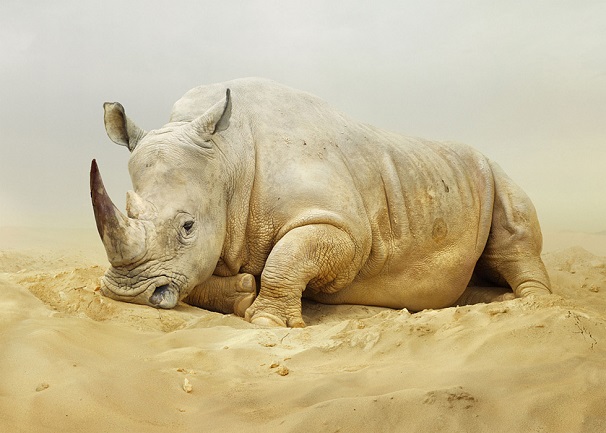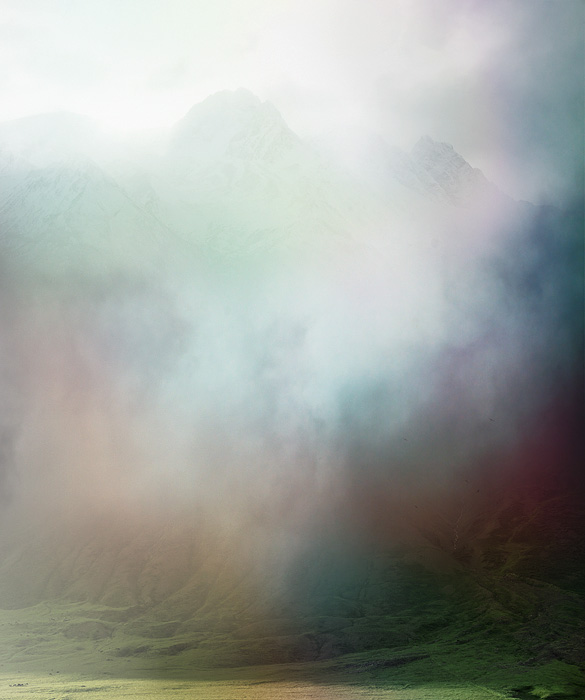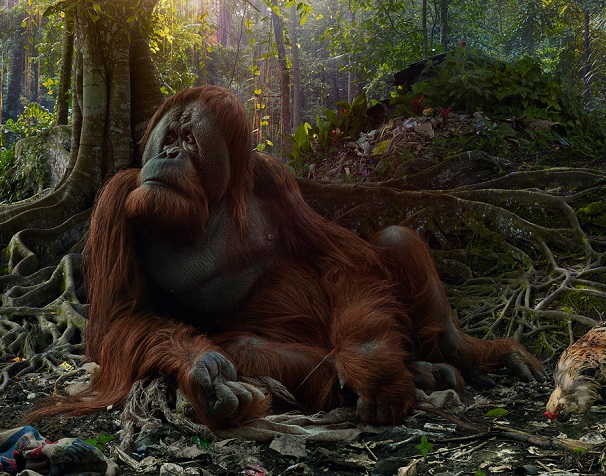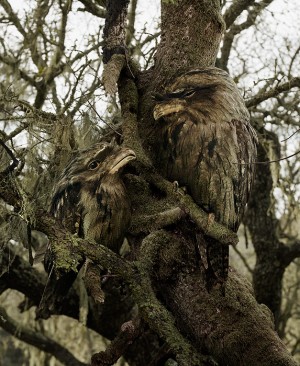Artist of the Week 12/23-12/30: Simen Johan Captures Reality and Fantasy through Animals
GALO: The photographs are fabricated and digitized, which at times is a bit confusing or unsettling for the viewer. We do not expect to see owls on a park bench covered in fog. Is the viewer’s relationship to these photographs meant to parallel or mimic humans’ relationship to nature?
SJ: Humans are nature. There is a man/animal tension in the images, but the work is not about “us vs. them.” Everything is one. Our sense of reality and truth is to a great extent shaped by fantasy and delusion. Daily, we float in and out of consciousness, believing what our minds, our senses, our fears, desires, etc. tell us is real. Some of us manage to periodically or, if we’re lucky, permanently, awaken from this slumber, but even then it’s not about awakening to some x, y, and z answers and explanations, but about awakening to the wonder of everything.
The “unsettling confusion” you’re talking about is something that comes about when I try to articulate the instability of everything we take for granted and ponder life’s perplexities.
GALO: What do you think is the future for digitized and altered photography? Is “straight” photography on its way out or is it experiencing a resurgence?
SJ: For the same reason that photography never replaced painting, altered photography will never replace traditional photography. If you’re interested in the way the world appears, evidence, capturing moments in time, etc., you don’t want to mess with Photoshop, but if you’re trying to visualize something unseen, which I am, Photoshop is a great tool for that. With that said, not all images I make are Photoshopped. And I’ve also made sculptures for this series.

“Untitled #168, 2011 (Rino)” by artist Simen Johan. Photo Credit: Simen Johan.
GALO: How does this series compare to your other exhibitions? In some of your photographs, you’ve used children to convey impulsive or intuitive impulse. Do animals impart similar ideas?
SJ: In the earlier work, I portrayed a child’s world in which the primal need to explore and search for meaning manifested itself in mysterious and often ritualistic forms of creativity and play. The animal work is not about a search, but still about primal experiences without ego interference. It’s easier to identify with animals and children, because they are more like our own inner selves. As adults we build all sorts of surfaces and facades, take on identities and ideologies, etc. that are hard to penetrate and get real with.
GALO: This series, and your other work, contains a lot of eerie or gloomy elements. Is this a symptom of portraying something primal? Is the world eerie? Does the dichotomy and tension between the beautiful and the eerie lend to this effect?
SJ: The world is not eerie. The world is what it is and “we” are “it.” But when we’re lost in our egos — when we identify with our form, gender, personality, social status, ideologies, etc. rather than with our true being, we see the world as separate from us, and thus, as we start to question this world, we become faced with something terrifyingly vast. In our everyday reality we feel as if we know what’s up, but it takes very little really to shatter this illusion, and when it shatters, it can be traumatic. From a deeper perspective though, where we’re part of the world, not separate from it, the world is not eerie. We see how it magically caters to our well-being and survival, how even negative events are needed for positivity to blossom, and the uncertainty that we otherwise fear turns to wonder.

“Untitled #179, 2013 (Foggy Mountain)” by artist Simen Johan. Photo Credit: Simen Johan.
We’re used to fantasies that offer us an escape from the mundane or the promise of everlasting love, etc. In Hollywood-type of fantasies there’s a clear distinction between good and bad, right and wrong, etc. The fantasies I create, however, are ambiguous and unstable. The familiar coexist with the otherworldly; the serene with the sinister; the artificial with the natural. And this is where the eeriness comes in, rather than them containing actual eerie elements. We like for things to be either like this or like that, we don’t like uncertainty. But the world is uncertain, ambiguous, perplexing. Consciousness itself is at once the most familiar and mysterious aspect of our lives. So my blurring of boundaries is in an attempt to get to some sort of truth about the instability of meaning and perception, rather than at an attempt to scare people. Uncertainty is not a mystery to crack or something to escape, but something to acknowledge.
To get back to your first question, the reason why I might be doing this work is to find forms of reconciliation with my own predilection toward fantasies and illusions — my own tendencies to ignore reason. I’ve always been a dreamer, looking to the future for a better life, disregarding the present as a means to an end. And at certain points in my life — first after a bad acid trip, then after a snowboard accident that put me in a short coma, and later on a traumatic trip in Asia — I’ve come face to face with my own mortality, realizing that the future goals I’ve set for myself, that were supposed to result in bliss, came and left without me ever noticing, and the future bliss I’ve imagined for myself will never come. This realization over the years has forced me to shift my focus toward the present moment, pick up meditation, and to ultimately become more in tune with the reality that there is only “now.” Yet my increased awareness hasn’t stopped the fantasies and nightmares from coming or for the ego to go away, so my work continues to be a mash-up of presence, nightmare and fantasy with a splash of irony, because in the end, it’s rather silly how the mind works and perceives things.

“Untitled #175, 2013 (Orangutan)” by artist Simen Johan. Photo Credit: Simen Johan.
GALO: In your artist statement, you explain that the title refers to the fantasy that life will come to a beautiful resolution, but the word “until” represents an ongoing process as opposed to a resolution or ending. Do the photographs in this series represent the fantasy of resolution or the process?
SJ: I think you misunderstood the second half of the paragraph, “until” in a reality where understanding is never total; I depict “living” as an emotion-fueled experience, engulfed in uncertainty, illusion and desire. “Until the kingdom comes,” refers to the human predicament of always wanting something else than what is presented. “The world is not enough.” “I am not enough.” “Life is not enough.” So we construct meanings, surfaces and facades that make us feel as if though life is complete, where meaning is not up for grabs. Yet this notion of incompleteness never escapes us, so we look to the future. If life sucks now, maybe after we die, we’ll go to heaven and everything will be bliss. This human predicament distorts our experience of the present moment, and of the world and of our selves. We blindly pursue what we desire, escape what we fear, rarely [do] we take time to simply observe and accept things as they are. But if we stopped running and searching, we might discover that we already are and have everything we ever wanted — that the kingdom is really the here and now.
My work is experiential by the way. These images are not literal representations of these ideas, but they echo my experience of living under these predicaments. Superficially, the title implies a journey/search toward a blissful future that in all probability will never come, but it also echoes the journey towards self-discovery.
GALO: With this series now complete, what are you currently working on?
SJ: A few different things; [however], I’m not sure what they will turn into yet.
For more information about this series or the artist, please visit http://www.simenjohan.com/.











